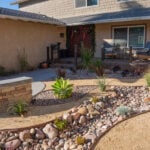As our global consciousness shifts towards environmental preservation, the significance of water-efficient landscaping design amplifies. In the face of escalating concerns regarding water scarcity and the urgent need for conservation, reevaluating conventional landscaping practices transcends being a mere choice; it evolves into an imperative obligation.
Water-efficient landscaping, often referred to as xeriscaping, stands at the forefront of this transformation. It represents more than an alternative; it symbolizes a harmonious convergence of aesthetics and resource preservation. This approach harmonizes with nature’s rhythms, demonstrating that sustainable living can coalesce seamlessly with beauty and functionality. It’s an embodiment of responsible choices and thoughtful design, bridging the gap between ornate landscapes and conscientious resource management.
Understanding Water-Efficient Landscaping
Water-efficient landscaping involves strategic planning, design, and maintenance practices aimed at minimizing water usage without compromising the beauty or functionality of outdoor spaces. It embraces the natural environment’s characteristics and reduces reliance on excessive irrigation, offering a host of benefits that extend beyond water conservation.
In its essence, water-efficient landscaping is a narrative of thoughtful design, a narrative that transcends beauty and functionality, weaving a tale of coexistence and symbiosis with our natural world. It’s a narrative that inspires, as it paves the way for landscapes that thrive in harmony with their surroundings, serving as a testament to the balance we can strike between human innovation and the preservation of our planet’s precious resources.
Principles
- Planning and Design
Successful water-efficient landscaping begins with thoughtful planning and design. Understanding the local climate, soil composition, and native plant species is crucial. By carefully selecting drought-resistant plants native to the region, designers can create visually stunning landscapes that thrive without excessive watering.
- Soil Improvement
Improving soil quality is pivotal in water-efficient landscaping. Amending soil with organic matter enhances its ability to retain moisture, reducing the need for frequent watering. Mulching is another effective technique that not only conserves moisture but also suppresses weed growth and insulates the soil, maintaining a stable temperature for plant roots.
- Efficient Irrigation Systems
Incorporating efficient irrigation systems such as drip irrigation or soaker hoses ensures water is delivered directly to plant roots, minimizing evaporation and runoff. Smart controllers equipped with weather sensors adjust watering schedules based on real-time weather conditions, optimizing water usage.
- Practical Turf Areas
Limiting expansive lawns in favor of practical turf areas or opting for synthetic turf reduces water consumption significantly. Integrating pathways, patios, or gravel beds can add diversity and functionality to the landscape while reducing the area that requires regular watering.
Benefits Efficient Landscaping
- Water Conservation
The primary benefit of water-efficient landscaping is evident in the substantial reduction of water usage compared to traditional landscaping methods. By utilizing native, drought-tolerant plants and smart irrigation techniques, homeowners can significantly lower their water bills while conserving this precious resource.
- Cost Savings
Reduced water consumption directly translates to cost savings. Water-efficient landscaping minimizes the need for excessive irrigation, leading to lower water bills. Additionally, the decreased reliance on maintenance, such as mowing and fertilizing, further reduces overall landscape management expenses.
- Environmental Impact
Embracing water-efficient landscaping practices contributes to a healthier environment. Less water usage means reduced strain on local water sources and ecosystems. Moreover, the use of native plants fosters biodiversity and supports local wildlife, creating a more sustainable and balanced ecosystem.
- Increased Property Value
A well-designed water-efficient landscape enhances a property’s curb appeal and can increase its market value. The aesthetic appeal coupled with the growing demand for eco-friendly features in homes makes water-efficient landscaping an attractive investment for homeowners.
Implementing at Home
- Assessing the Landscape
Begin by evaluating the existing landscape to identify areas that can be optimized for water efficiency. Consider factors like soil quality, existing plants, and water usage patterns.
- Plant Selection
Choose native plants and drought-resistant species suited to the local climate. Group plants with similar water requirements together, creating zones that can be irrigated more efficiently.
- Efficient Irrigation
Install water-efficient irrigation systems that deliver water directly to the roots of plants. Regularly check for leaks, adjust watering schedules seasonally, and consider rainwater harvesting as an additional water source.
- Sustainable Maintenance
Adopt sustainable maintenance practices, including proper mulching, periodic soil amendment, and regular inspection of irrigation systems to ensure optimal performance.
Creating Sustainable Havens
Water-efficient landscaping design is a sustainable approach that not only conserves water but also enhances the beauty and functionality of outdoor spaces. By embracing principles of xeriscaping, homeowners can create landscapes that thrive in harmony with nature while contributing positively to the environment and their community. Embracing this eco-conscious approach to landscaping ensures a greener future for generations to come.
Through the principles of xeriscaping, homeowners craft landscapes that exist in harmony with their surroundings. By selecting indigenous plants and employing efficient irrigation methods, these landscapes become resilient, requiring minimal maintenance while blossoming with life.
Yet, the impact extends beyond individual properties. It ripples into communities, inspiring others to adopt similar practices and fostering a collective commitment to environmental stewardship. Water-efficient landscaping isn’t merely a trend; it’s a cornerstone of a greener, more sustainable future, leaving a legacy of responsible living for generations ahead. It’s a testament to our ability to coexist with nature, nurturing landscapes that thrive and flourish while preserving precious resources for the world we share.






